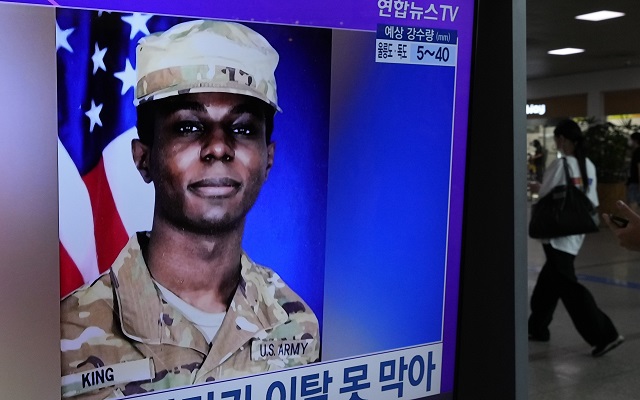UN Command says it’s communicating with North Korea about detained US soldier

By KIM TONG-HYUNG Associated Press
SEOUL, South Korea (AP) — The American-led U.N. Command said Monday it has started a conversation with North Korea about a U.S. soldier who ran into the North last week across one of the world’s most heavily fortified borders.
Andrew Harrison, a British lieutenant general who is the deputy commander at the U.N. Command, refused to say when the conversation started, how many exchanges have taken place and whether the North Koreans responded constructively, citing the sensitivity of the discussions. He also declined to detail what the command knows about Pvt. Travis King’s condition.
“None of us know where this is going to end,” Harrison said during a news conference in Seoul. “I am in life an optimist, and I remain optimistic. But again, I will leave it at that.”
It wasn’t immediately clear whether Harrison’s comments referred to meaningful progress in communications after the command said in a statement last week that it was “working with” its North Korean counterparts. The U.N. Command, which was created to fight the Korean War, has remained in South Korea to supervise the implementation of the 1953 armistice that stopped the fighting in the conflict.
The contact happened through “mechanisms” set up under the armistice, Harrison said. That could refer to the so-called pink phone, a telephone line between the command and the North Korean People’s Army at the border truce village of Panmunjom, where King crossed.
The Koreas are still technically at war since a peace treaty was never signed. The U.S., which fought alongside the South Koreans and other allies during the war, never established diplomatic relations with the North, but the line is a common way they communicate.
North Korea has remained publicly silent about King, who crossed the border during a tour of Panmunjom, while he was supposed to be heading to Fort Bliss, Texas, following his release from prison in South Korea on an assault conviction.
U.S. officials have expressed concern about his well-being and said previously that North Korea ignored requests for information about him.
Analysts say North Korea may wait weeks or even months to provide meaningful information about King to maximize leverage and add urgency to U.S. efforts to secure his release. Some say North Korea may try to wrest concessions from Washington, such as tying his release to the United States cutting back its military activities with South Korea.
King’s crossing came at a time of high tensions in the Korean Peninsula, where the pace of both North Korea’s weapons demonstrations and the United States’ combined military exercises have intensified in a tit-for-tat cycle.
On Monday, South Korea’s military said a nuclear-propelled U.S. submarine arrived at a port on Jeju Island. The arrival of the USS Annapolis adds to the allies’ show of force to counter North Korean nuclear threats.
Last week, the USS Kentucky became the first U.S. nuclear-armed submarine to come to South Korea since the 1980s. North Korea reacted to its arrival by test-firing ballistic and cruise missiles in apparent demonstrations that it could make nuclear strikes against South Korea and deployed U.S. naval vessels.
North Korea’s defense minister also issued a veiled threat, saying the Kentucky’s docking in South Korea could be grounds for the North to use a nuclear weapon against it. North Korea has used similar rhetoric before, but the statement underscored how strained relations are now.
The United States and South Korea have expanded their combined military exercises and increased regional deployments of U.S. aircraft and ships, including bombers, aircraft carriers and submarines in a show of force against North Korea, which has test-fired around 100 missiles since the start of 2022.
The Annapolis, whose main mission is destroying enemy ships and submarines, is powered by a nuclear reactor but is armed with conventional weapons. The Annapolis mainly docked at Jeju to load supplies, but Jang Do Young, a spokesperson of South Korea’s navy, said the U.S. and South Korean militaries were discussing whether to arrange training involving the vessel.






